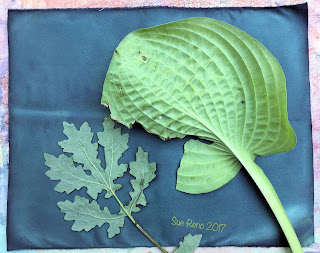It's time for more wet cyanotype fun! Here's another batch of experimental prints using the wet cyanotype method of printing on fabric. If you are new here, welcome, and feel free to look back at the explanations in
Part 1,
Part 2,
Part 3, and
Part 4. I've also added a tab to to the blog header that will give you
all the relevant posts in reverse chronological order.
This time around I was working exclusively with cotton sateen that I treated myself with cyanotype solution. I spritzed a bit of water on the foam board base, added the fabric, placed the leaves, gave it another spritz, and covered it all with a sheet of glass. I started with 'August Moon' hosta leaves, above, and an ornamental sweet potato vine, below.
Below is another hosta leaf that sustained some damage, and a wood poppy leaf. For these first three the first spritz of water had a bit of dye-na-flow pink color added; the rest were all plain water.
Here is a christmas fern frond. You can never have too many fern prints.
Up next were two daisy sprigs. Using flowers in regular cyanotype printing, where the exposure is 10 - 15 minutes, can be a bit tricky, and the delicate petals are more translucent to light than the leaves, and its hard to find the right balance. So I was curious to see what would happen with the wet cyanotype process with these.
Last up in this batch was a wonderful snake root compound leaf on a 16" x 20" panel.
All of these were left outside for approximately 24 hours. The weather was sunny, hot, and very humid. After exposure, they looked like this:
They were very dark and moody looking. I like taking photos as this stage because it is very transient.
I somehow skipped taking a photo of the fern at this point, probably because I got distracted by these daisy prints:
The flowers are fairly well represented, but the leaf impressions got melt-y, perhaps because of the moisture in the leaves and stems, or possibly it became a focal point for the condensation on the glass.
And the snakeroot print was
really dark at this point.
After rinsing, drying, and ironing, here are the finished prints. Once again, I am just in love with the results this process produces. The golden mottling here is just great:
This one is a particular favorite:
And again, you can never have too many fern prints.
I'm not sure how I feel about these daisy prints. They seem somewhat unsettling to me. I can see how some stitch work to define and/or enhance some of those melt-y bits and the flowers could be really effective. Or not. I'm not sure I want to invest a lot of time in them. They will go up on a design wall so I can think about them for a while.
Last but not least, the snakeroot print turned out very lovely. I love the purple tones and all the shading in the leaves.
I took a break from the printmaking frenzy at this point because I had run out of treated fabric, and I had other things I needed to attend too. But there will be more to come....
As always, thanks for reading and commenting!
July 2022 Update: This post has been doing some numbers, so I wanted to say hello, and thank you, to everyone stopping by. I also wanted to let you know that this exploration turned into a series of 78 posts, and counting! You can easily access them, in reverse chronological order, by clicking on the Wet Cyanotype tab in the top header. I share a lot of details about what I've tried, and am always honest about the results in each post. Mixed in is the occasional post showing artquits I've made with my prints. I hope you enjoy reading my blog, learn a thing or two, and try your own hand at this very enjoyable process.
Thanks as always for reading! You can also follow along on your platform of choice:
August 2023 Update: Still doing some numbers, still doing new experiments! I'm up to Experiments in wet cyanotype - part 83 and I continue to be grateful for all the interest and support. Here's the updated list of my socials, I'd love to have you follow along on the platform of your choice:






















































